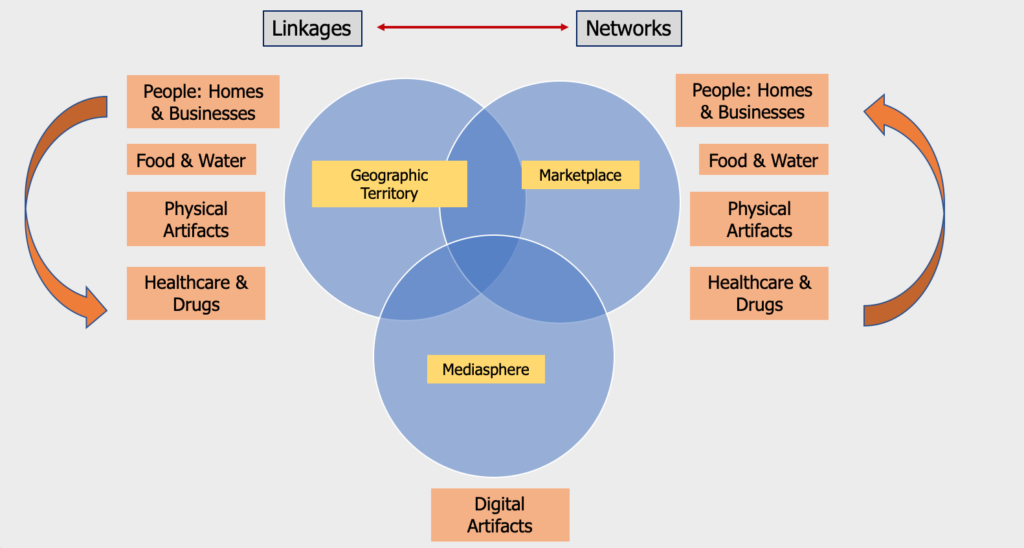“Pathogen outbreaks are an emergent property of global 21st century society,” Dr. Richard Hatchett, executive director, Coalition for Epidemic Preparedness (CEPI), Bloomberg BusinessWeek, Feb. 13, 2020
As a society, we are obviously becoming increasingly more connected. Most of the time, we don’t realize the fragility caused by our interdependence. We take our connections among and between people, physical artifacts and digital artifacts for granted and seem them as benign as the sun rising in the East and setting in the West.
Until COVID-19 emerged in late 2019, all of our discussion about connectedness was framed almost entirely on social networks, networks more generally and, of course, network effects (i.e., the Big Tech companies – that we voluntarily use – that are ruining (or is that running?) our lives and ruining society).
COVID-19 is cutting society’s connections
The emergent properties of our global 21st century society have been primarily related to digital: cyber risks; social media that enable bullying, spreading misinformation and amplifying outrage; and "trial by Twitter."
But a global pathogen has supplanted our discussion about emergent digital issues. With COVID-19 cascading through country after country, the world is going into quarantine as we experience:
- entire countries being locked down
- major sections of countries being shut down
- conferences around the world being canceled or moved to a virtual format
- colleges asking their students to leave campus and attend classes virtually
- businesses asking their employees to work from home
- shopping malls being abandoned
- sports games being played without fans
- "social distancing" (not shaking hands and staying at least six feet away from another person) and vigorous hand-washing being strongly recommended practices
- panic buying in some locales, with people stripping grocery stores bare of items needed for hand cleaning, sanitizing and bathrooms.
All of the above are natural human reactions to a pathogen infecting hundreds of thousands and killing thousands of people, that to date does not have a vaccine or a course of treatment.
Moreover, all of the above, other than the guidance relating to hygiene, are drastically slowing or stopping commerce around the world.
Per an article in Fortune.com dated March 11, 2020:
“Nearly 75% of companies are seeing capacity disruptions in their supply chains as a result of coronovirus-related transportation restrictions, according to an Institute for Supply Management survey published Wednesday (March 11, 2020). This is a strong warning that COVID-19 is weighing down the global economy.”
I’m not arguing that the measures being taken should not be taken. I am glad that all of the actions are being taken. That doesn’t alter the fact that commerce, or the pace of commerce, is grinding to a halt.
(Personally, I believe that every U.S. state and international communities should cancel their entire schedule of events for the spring and summer, including fairs, festivals, music events, theaters, outdoor plays, college commencements and other social gatherings until a vaccine or course of treatment for COVID-19 is identified and made available to everyone.)
See also: Coronavirus Boosts Cyber Risk
Hoisted on our own petard (of connections)
As a society, we are currently being hoisted on our own petard: A natural phenomenon is driving us to cut our global and regional (and local) connections or at a minimum put them on the shelf. COVID-19 may not be taking society back to the Middle Ages, but it seems as if it is taking society back to a time before any significant amount of global trade was conducted through systems of linkages or networks.
Society can not become completely digital
I realize there are probably quite a few people who see COVID-19 as an opportunity for society to become entirely, or at least mostly, digital. We may be forced to strive to make that happen until we have a vaccine or course of treatment for this pathogen.
However, a significant component of society is, and will always remain, analog. Physical artifacts are not going to disappear. I believe that significant parts of our society can become even more dependent on digital interactions (what I label Mediasphere in the visual below). But the practical reality is that people need, at a minimum, to have:
- food to eat and utensils (and plateware)
- water to drink and containers for the water
- clothing
- medicine (over-the-counter or prescription) and containers to store the medicine
- a choice of physical artifacts to sit on for homes and offices
- a choice of vehicles to share/own/lease
- groceries and storage, plus carry-bags for the groceries
- appliances in homes and offices (for any number of practical reasons)
- infrastructure to move:
- food, water, medicine and medical devices
- physical artifacts
- trains, planes and trucks to move food, water, medicine, medical devices and other physical artifacts from one terrestrial point to another terrestrial point.
COVID-19 or not, our society is, and will remain, a mixture of physical and digital artifacts.
Societal connections: linkages and networks
Humans have been building linkages and networks to support interactions with each other throughout the history of our species on our planet. We are an animal that communicates in a wide variety of ways, including speech, art, trade and an ever-expansive set of tools. From the Cave Walls of Lascaux to the walls of Facebook, from the Silk Road to ocean maritime shipping and from party-line telephones to ubiquitous, mobile IP-connected telephony, humans have continually created and expanded communication pathways to share, shop and entertain.
I am purposely not defining or discussing the differences between linkages and networks. Additionally, a more robust discussion would also include ecosystems and platforms and the impact of global pathogens on both of them. But I will say that I consider the walls of Lascaux, the Silk Road, ocean maritime shipping and party-line telephones to be linkages rather than networks.
Three major domains of society’s linkages and networks
In the visual below, I attempt to capture three major domains of society’s linkages and networks and some of the key elements in the two historic domains of geographic territories and marketplaces:
- Geographic Territory: A small village or a town, city, state, province or entire country. The territory consists almost entirely of physical artifacts but is increasingly leavened with digital capabilities (i.e. IoT).
- Marketplace: Where people and businesses go to shop and purchase goods (including food, water and medicine) and services (including healthcare). Throughout most of our existence, the marketplace has been entirely composed of physical artifacts. However, as society has become more computerized, more digital, more mobile and of course connected using the Internet and web, the marketplace is increasingly a locus of both physical and digital artifacts.
- Mediasphere: My made-up term to mean a digital arena that supports communication, commerce, entertainment, virtual office work, news and other digital services (i.e., virtual reality, augmented reality, holograms). The Mediasphere consists entirely of digital artifacts. (Other than that the infrastructure that enables the very existence of the internet is itself a portfolio of physical artifacts.)
COVID-19, an emergent property of our 21st century society as Dr. Hatchett stated, affects all three domains. The pathogen is effectively slowing or closing the interactions between and among people and physical artifacts within geographic territories and the marketplace.
Simultaneously, COVID-19 is transforming the Mediasphere into a crucially important domain for humans to interact digitally whether for business, education, news, entertainment or other digital services. As some articles in the press have noted: COVID-19 will really test the limits of the digital haves and have-nots. This pathogen may be the trigger that finally motivates governments to ensure their entire populations can access the web and do so in a cost-effective manner (for consumers).

Implications and advice for insurers
During the COVID-19 crisis, insurers should:
- ask all of their employees, whether now working in the home office, a field office or an agency, to work from home
- provide the necessary equipment, and requisite security and privacy, for their employees to work from home
- hold meetings virtually
- strengthen the security of all of the company’s digital connections (including data flows within the company’s value chains and flows to/from external sources)
- ensure that employees have the necessary telecommunications access to the content (forms, documents, files, presentations, other) they need to perform their work at home, including uploading the work from each employee
- ensure that employees can be tested for the COVID-19 virus from home.
For sales, claim service and customer administrative service, insurers should also create the infrastructure, processes and access to the requisite content for interactions with clients and claimants to be done virtually. Insurers that are using video solutions to fulfill these interactions will create more satisfied clients and claimants.
See also: Coronavirus: What Should Insurers Do?
Prepare for post-COVID-19 times
Insurers need to be ready for the time the current global pathogen is contained (by vaccine or course of treatment) by:
- maintaining constant awareness of what events, even events that seem outlandish, could shred the firm’s connections
- considering if it is possible to (profitably) offer new insurance covers to mitigate the risk of pathogens (even thought they are very low- frequency and very high-severity events) beyond business interruption or cancellation insurance
- creating analytical templates of “density of risk” territory profiles that illustrate the distribution of client ages and the distribution of clients' chronic conditions and diseases in each territory where the firm has insurance clients.
What else would you suggest for insurers to do both during this current pathogen crisis and for the time after COVID-19 is resolved?








